Replacing a sewer system in an apartment with your own hands: detailed instructions for replacing a riser and pipes
In older apartment buildings, the number one problem is often faulty drainage.Agree, it’s unpleasant when the acrid smell of sewage spreads throughout your home, blockages constantly form, or your neighbors are flooded due to leaking old sewer pipes. Replacing the sewer system in the apartment can correct the situation.
If you involve specialists, updating the sewer system can cost a pretty penny. But you can take care of this issue yourself. And we will tell you how to do this in our article - we will talk about how to choose suitable pipes, and we will also provide detailed instructions with visual pictures for replacing the riser and pipes in the apartment.
The content of the article:
Types of pipes and tips for choosing
Before dismantling the old sewer system begins, you need to count all the existing water intake points in your home and make a diagram new sewer. They take into account not only the plumbing, but also the devices to which the sewer pipes are connected.
Based on the diagram, the required number of pipes and additional elements are calculated: couplings, adapters, bends, and so on. To avoid problems with fitting components during the installation of the system, it is better to buy all materials from one manufacturer.

Characteristics of ceramic sewer pipes
Such pipe products are made from high quality refractory clay. Inside they are covered with a layer of clay glaze, which prevents moisture from being absorbed into the material.
Pipes are produced with a diameter of 10-60 cm and a length of 100-150 cm. Overall dimensions and properties allow their use in sewer systems.
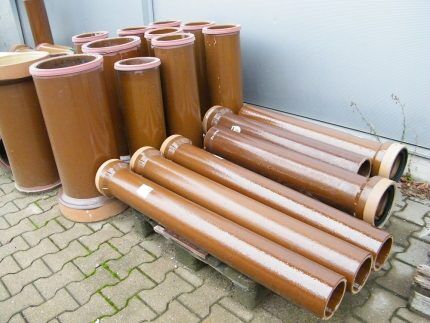
The main advantages of ceramic pipes include resistance to corrosion and aggressive environments.
Among the disadvantages, it should be noted the possibility of damage due to a strong impact. In addition, the products are short (maximum 150 cm), during the installation process they will have to be connected to each other more often, and this is both more expensive and more effort will be expended.
Features of steel and cast iron pipes
Pipes made of steel or cast iron are also used for laying sewers. Steel tubular products can transport substances with high temperatures. They are durable and inexpensive. However, they are not suitable for installation in apartments, as they are prone to corrosion.
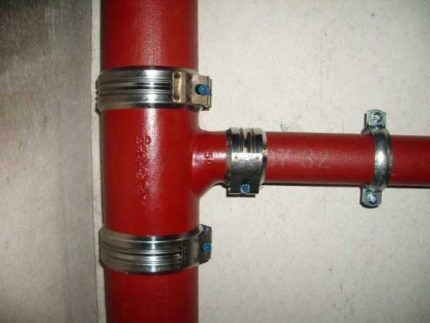
Unlike steel cast iron pipes more resistant to corrosion processes. Cast iron can be used in the sewer system both externally and internally. The design will be durable and will last a long time.
However, if there is a need to replace such sewer pipes in an apartment, the use of additional installation equipment will be required.The disadvantages of tubular products include high cost and heavy weight.
Basic properties of polymer pipes
The best option for internal sewer systems are stabilized polypropylene pipes. They are available in gray color and are made using the hot extrusion.
Main advantages:
- The inside walls are completely smooth – waste easily slides into the pipe without forming deposits on the surface.
- A light weight – it’s easy to work with pipes even alone. The finished drain circuit is definitely not capable of pushing through the floor covering.
- Corrosion resistance – polymers do not rust, so you don’t have to worry that the pipe will become leaky over time and leak.
- Can transport waste with high temperature conditions – the material begins to melt at a temperature of +175 °C.
- Quick installation and easy maintenance – there is no need to paint the pipes, they are simply wiped clean of dust. If any section of the pipe fails, it can be easily replaced without dismantling the entire sewer system.
There are also polyvinyl chloride (PVC) pipes. They are resistant to ultraviolet radiation and have good strength.
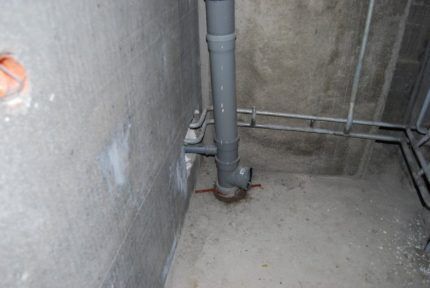
PVC pipes can be used in the sewer system, but when heated, the material releases harmful substances. Therefore, they are more often used for arranging external sewer system. In addition, such pipes have low resistance to aggressive environments and their surface wear resistance is worse than that of polypropylene options.
Polymer pipes are connected to each other using the socket method - the narrow end of one pipe is placed in the socket (widened part) of the other. To seal a pipe connection use sealing material.
We discussed more recommendations and features of choosing pipes for internal sewerage in next article.
Step-by-step replacement instructions
The tools you will need are a drill or hammer drill, a mounting gun, a chisel, a hammer, an adjustable wrench, an angle grinder, a level and a pencil. The set of necessary devices depends on the type of connection and material of the sewer pipes: ceramics, metal or polymers.
Stage #1 - dismantling the old sewer system
Owners of upper-floor housing can immediately begin work on replacing the sewer system. The rest of the residents of multi-storey buildings, before replacing the old sewage system in their apartment, need to warn their neighbors above so that they do not drain the water yet.
Before starting dismantling work, you should turn off the water and disconnect all plumbing fixtures so as not to damage them during the repair work. Old pipes that are adjacent to the riser must be cut into a convenient place and removed from the pipeline system. After this, they begin to dismantle the riser. All this must be done carefully so as not to damage the pipes that go to the neighbors.
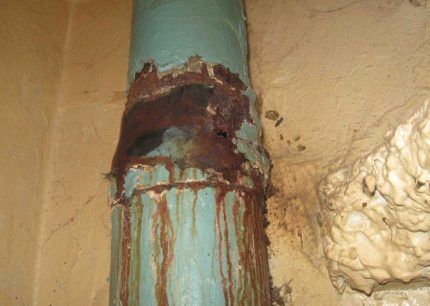
Dismantling algorithm:
- At a slight angle Bulgarian make two horizontal cuts: the first with a distance of 10 cm from the ceiling, the second - 80 cm from the tee.You should not immediately cut the pipe to the end, because you can jam the grinder disc.
- The chisel is applied to the upper cut - you need to hit it with a hammer. Carry out the same manipulation with the lower incision. The old cast iron pipe located between the cuts should split and its pieces can then be easily removed.
- The part of the pipe sticking out from the ceiling is covered with film.
- Disassemble the lower part of the riser with the tee and fittings. You can loosen the soured tee fastening with a crowbar. The cement at the tee connection points is removed using a hammer drill.
- Remove the old tee from the system. If the tee cannot be removed, then the fitting is cut off with a grinder, 3 cm away from the socket.
- The remaining pipes are being prepared for the installation of a new riser. Contaminants should be removed and the ends of the pipes should be sanded.
The quality and speed of installation of a new sewer system depends on the correct dismantling of the old sewer system.
Stage #2 - assembly and installation of the riser
The sewer riser in high-rise buildings is a complex structure. To replace it in an apartment, you will need polypropylene pipes with a diameter of 110 cm, a tee with bends made of the same material, clamps or a special mount for the riser.
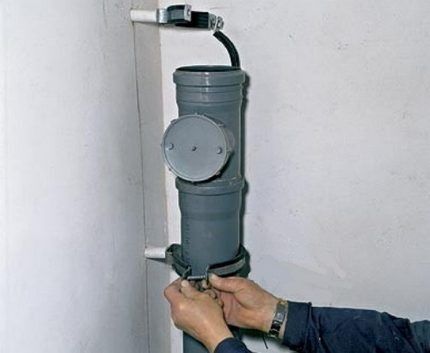
To arrange the transition between the remains of a cast iron pipe and plastic pipe products, you need to purchase rubber cuffs, as well as a compensation pipe.
You will also need liquid soap during the installation process.It is applied to the edges of the pipes, thereby facilitating their entry into the connecting elements. You will also need a vertical level.
First, install the tee at the bottom. To do this, it is inserted into the pipe socket with a rubber cuff and the resulting joint is sealed with winding or sealant. The gap between the vertical pipe and the tee should be minimal - no more than 10 mm.
You should also attach a rubber collar to the end of the pipe that sticks out from the ceiling. Next, a special adapter is connected from above.
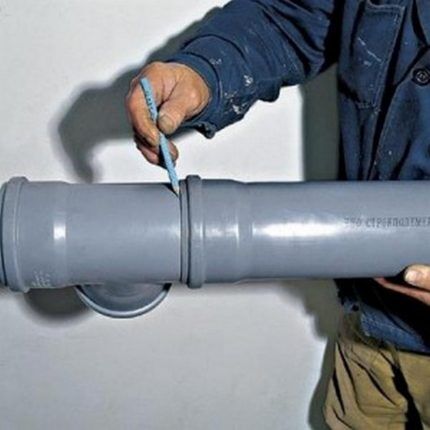
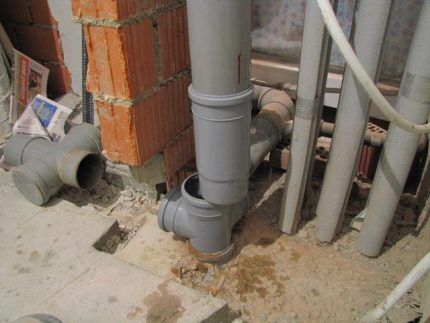
Try on the riser pipe and cut off the required length. Perform a test fitting of all elements with the compensators already on.
Afterwards, the fastenings are marked and the upper and lower clamps are installed. If there is a small gap between the wall and the future riser (up to 7 cm), the clamps are attached with dowels. In another case, metal corners or a board pre-treated with an antiseptic are first attached to the wall.
Rubber gaskets are inserted into the structure and the riser is mounted in the lower tee. Then connect the upper part and tighten the clamps. In apartments with a standard ceiling height, three clamps are usually used for fixation.
Stage #3 - internal piping
But the inner one pipe routing performed according to a pre-designed scheme, starting from the riser. Afterwards, the plumbing is installed and connected.
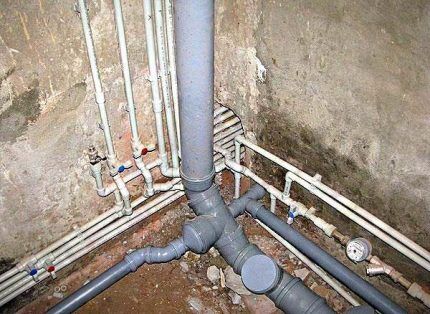
The pipe fastening must be combined: rigid and in some places floating. Otherwise, internal tension cannot be avoided.
Nuances of the work:
- in order to prevent the system from leaking, the sockets should be mounted towards the movement of the drains;
- sewer system slope done towards the riser;
- the shape or dimensions of shaped parts cannot be changed;
- the connection of the riser and the outlet pipe cannot be made at a right angle.
When the installation work is completed and all plumbing is installed, the system needs to be tested. To do this, drain water from all appliances, look at the outflow rate and check for leaks.
Conclusions and useful video on the topic
Visual instructions for installing sewer pipes are given below:
Almost anyone can change the sewer system in their apartment on their own. Especially if the system is made of polypropylene pipes. No welding is required to connect them. The pipes are inserted into a socket with rubber gaskets, and perfect sealing is achieved using sealant. Installation of such a sewer system will be inexpensive, and it will last longer than cast iron.
Have you recently changed the sewer system in your apartment and want to share your experience with other users? Tell us what difficulties you encountered in the process of replacing the riser - the comment form is located below.
If you have questions about the topic of our publication, do not hesitate to ask our experts for advice - we and other site visitors will try to help you.



